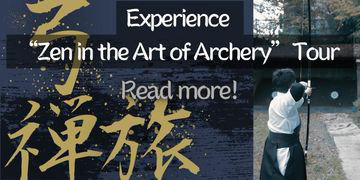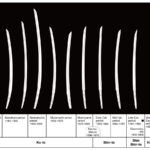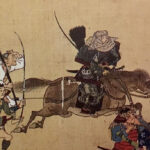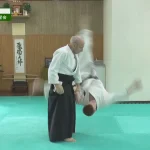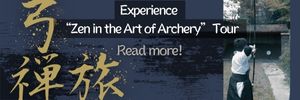The Two Pioneering Overseas Okinawa Karate Demonstrations 1927 & 1951 Honolulu (Hawai’i) & São Paulo (Brazil)
Text by Yannick Schultze
Translation by Sanae Nadoyama
At times, to analyse the history of Okinawan karate more deeply, it is necessary to investigate newspapers published overseas and conduct interviews with the descendants of karate masters. This is because most of the materials in Okinawa were lost due to the devastation of the Pacific War and no longer exist. Therefore, it will continue to be important for researchers to compare and verify the materials available from overseas with the stories that have been passed down to the present.
Now, I would like to introduce the karate promotion activities that took place in 1927 and 1951, based on articles from Japanese newspapers published overseas.
Background of Yabu Kentsū and the Demonstrations
In previous installments, I have introduced research findings related to “Yabu Kentsū’s biography” and the kata “Jion”. In those discussions, we also touched upon Yabu Kentsū’s karate demonstration event in Hawai’i in 1927 and mentioned Yabiku Mōtoku (1886-1951), one of Yabu’s early disciples. The demonstration event in Hawai’i, which I will now introduce, was conducted under the supervision of Yabu Kentsū, but the demonstration in Brazil took place 14 years after Yabu Kentsū’s death. From my perspective, the historical significance of this demonstration is not dimished. This is because Yabiku Mōtoku, having been directly instructed by Yabu Kentsū during his time at the Okinawa Normal School (Shihan Gakkō), allows us to understand the background of karate history through the activites of Okinawan karate practitioners who went abroad.
Okinawan Immigration to Overseas
Politician Tōyama Kyūzō began to see Hawai’i as a promising future destination for emigration. In fact, in 1885, an agreement was reached between the Japanese and Hawaiian governments allowing Japanese laborers to work on sugar plantations under three-year contracts. Despite this agreement and the promotion of emigration from the southwestern islands to Hawai’i, awareness of this initiative was low and it was hardly known. Tōyama Kyūzō, known as the “Father of Okinawan Overseas Emigration” , tirelessly campaigned for this cause. As a result of his persistent efforts, 200 young people from various professions across Okinawa applied for the opportunity. Ultimately, 30 individuals aged between 21 and 35 were accepted as the first contract labor emigrants. On December 5, 1899, they departed for Hawai’i. Tōyama himself also traveled to Hawai’i during the second wave in 1903, leading the group, and continued to be involved in emigration projects to both North and South America.
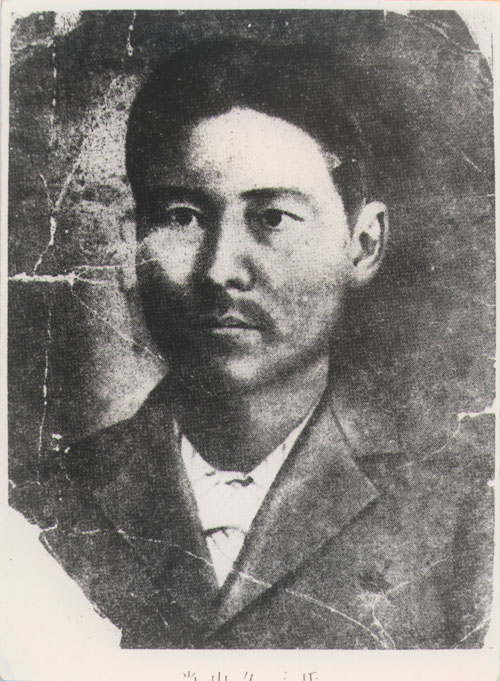
Tōyama Kyūzō (1868-1910) [Courtesy of the “Naha City Museum of History”]
As a result of this labor emigration plan, it is estimated that approximately 20,000 people from Okinawa relocated to Hawai’i between 1900 and 1924. In most cases, the head of the household would first enter Hawai’i, establish a stable living situation, and then bring their family from Japan to join them in Hawai’i.
Travel Distance to Brazil at the Time
However, emigrating to Brazil was even more challenging than moving to Hawai’i. The voyage took at least three times as long as traveling to Hawai’i. If travelers took the route via Hong Kong, Singapore, Sri Lanka, and Cape Town (South Africa), the travel time increased further. The journey from Yokohama to Santos (São Paulo) took at least 1.5 months, even under the most conservative estimates.
The First Japanese Immigrants to Brazil

Kasato Maru
The first Japanese immigrants arrived in Brazil in 1908. A group of 781 individuals, primarily engaged in agriculture, boarded the Kasato Maru and traveled to Brazil. Half of these passengers were from Okinawa. Over the years, more Okinawans began to emigrate to Brazil. By 1938, approximately 14,830 people from Okinawa had emigrated to Brazil, including the families of Yabiku Mōtoku, the parents of Toguchi Reiji, and the parents of the Kokuba brothers, Seitoku and Seiyū. Similary to the practice in Hawai’i, the system of bringing over family members was also implemented in Brazil.
Karate Demonstration Event Held in Honolulu

Photo: Fundraising Advertisement for the Okinawan Bujutsu Karate Demonstration Event in Hawai’i (Published in Hawaii Hōchi, July 4, 1927)
At the time, the event was announced in a Hawaiian newspaper as follows: (Note: Due to copyright issues, the original document cannot be published. The following is a verbatim excerpt from the original text.)
Order of Demonstrations for the Okinawa Karate Event
At the Y.M.C.A. Hall on the night of July 8
The program for the Okinawa Karate Event, which will be held at the Y.M.C.A. gymnasium starting at 7 p.m. on the coming 8th (Friday), is as follows.
Date and Time: July 8 (Friday) Opening at 7:30 p.m.
Venue: Nu’uanu Young Men’s Gymnasium
Presenter: Tōyama Tetsuo
Regarding the Karate Association: Kawamae Kanshun
Karate Lecture: Yabu Kentsū
Explanation in English: Kurokawa [Colbert] Naoya
Karate practice session:
1. Bunkai Renshū All trainees
2. Kūsankū Miyazato Saburō
3. Gojūshiho (Children’s group) Tōyama Sadao, Uesato Haruo, Uesato Ryōki
4. Naihanchi Shodan – Nidan – Sandan All trainees
5. Sanchin Kojō Jirō
6. Pin’an All trainees
7. Gojūshiho All trainees
8. Naihanchi Shodan Teruya Ushi
9. Naihanchi Nidan Shiroma Jirō
10. Naihanchi Sandan Kiyabu Kiusei
11. Passai Nakama Ryōsonkin
12. Pin’an Kawakami Kitarō
13. Gojūshiho Kishimoto Ishun, Asato Sadao, Teruya Saburō, Tanisho Shōsan, Teruya Ushi
14. Kūsankū Shiroma Jirō, Higa Shingi, Azama Tarō
15. Main match Kawakami Kitarō, Kawamae Kanshun
16. Kūsankū Kawakami Kitarō
17. Gojūshiho Kawamae Kanshun
18. Gojūshiho Yabu Kentsū sensei
[Source: Hawaii Hōchi, published on Saturday, July 2, Shōwa 2 (1927)]
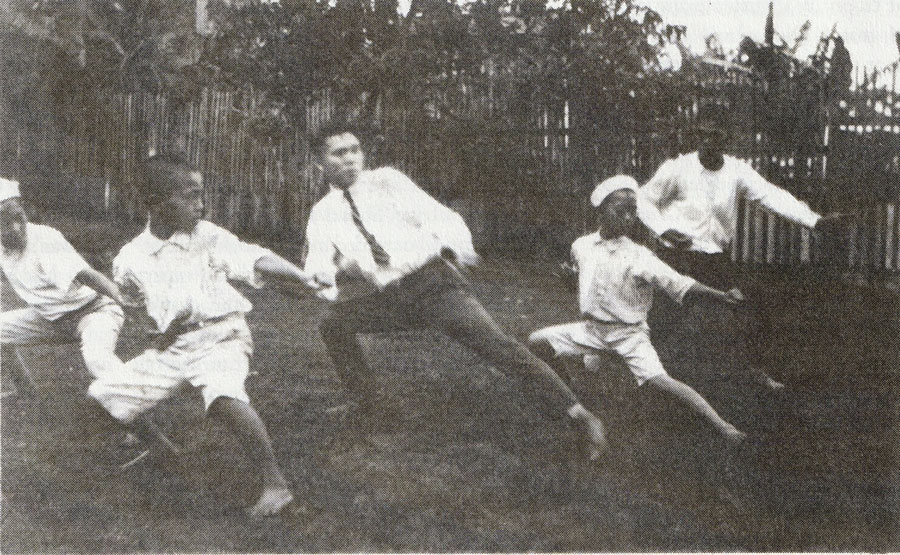
Photo: Teaching karate to kids in Hawai’i. Center: Kawamae Kanshun, right end: Shiroma Jirō [Courtesy of the Hawaii Karate Museum]
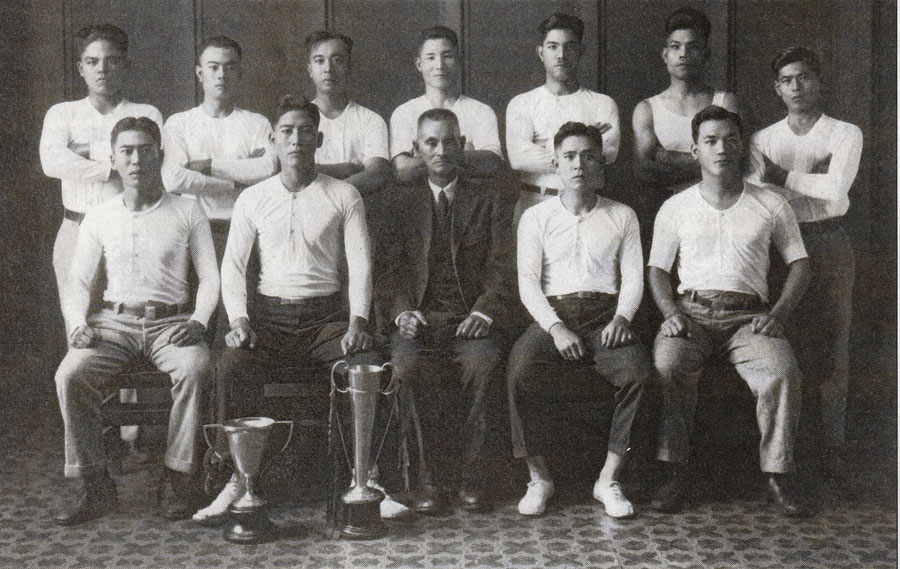
Standing from left to right: Shiroma Jirō, Higa Shingi, Teruya Saburō, Uehara Kamezō, Arakaki Sadao, Nakama Ryōsonkin, Azama Tarō. Sitting from left to right: Kiyabu [John] Kiusei, Kawamae Kanshun, Yabu Kentsū sensei, Kawakami Kitarō, Asato Sadao [Courtesy of the Hawaii Karate Museum]
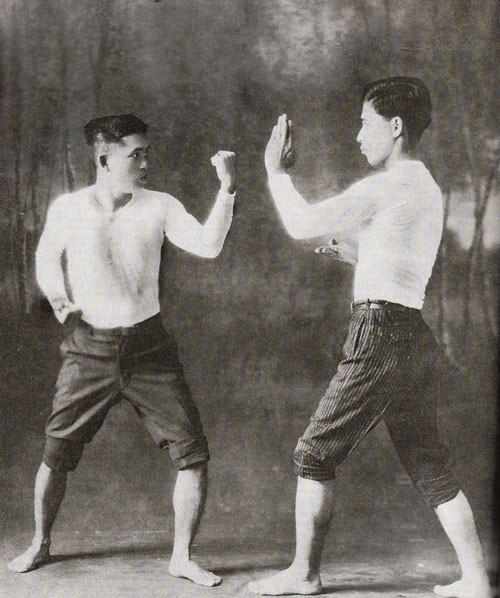
Kawakami Kitarō (left) ‘ Kawamae Kanshun (right) [Courtesy of the Hawaii Karate Museum]
Kawakami Kitarō and Kawamae Kanshun
Kawakami Kitarō was born in Okinawa in 1895. His father, Kawakami Kisaburō, was one of the first immigrants to Hawai’i. According to oral tradition, Kisaburō left his pregnant wife in Okinawa and went to Hawai’i alone in search of work in 1894. After establishing a stable living situation, he summoned his wife and son (Kitarō) to join him in 1910. Surprisingly, by the time the decision was made for the family left behind in Okinawa to immigrate to Hawai’i, Kitarō was already 15 years old. It is not certain whether Kitarō had learned karate before immigrating to Hawai’i Being from Naha, he likely had more exposure to karate compared to other regions, but there are no records confirming this. After emigrating to Hawai’i, Kawakami Kitarō married Yoshiko in 1920, and they had two children: a son, Hiroshi, and a daughter, Masako.

Kawakami Kitarō (left) ‘ Kawamae Kanshun (right) [Courtesy of the Hawaii Karate Museum]
Kawamae Kanshun was born in Okinawa in 1897. His father, Kawamae Tarurā, is recorded to have been living in Hawai’i since 1906, and his son Kanshun followed his father in 1914. According to the research of Charles C. Goodin, Kawamae Kanshun worked as a taxi driver in Honolulu and later found employment at a Chinese restaurant. He was reported to be a polyglot, fluent in Japanese, English and Chinese. Around 1934, Kawamae Kanshun returned to Okinawa, where he became well-known for his participation in Okinawan sumō tournaments. Later, he changed his name to “Kitatsu” and returned to Hawai’i around 1940. However, he returned to Japan shortly before the start of the Pacific War, with the attack on Pearl Harbor by the Japanese military in December 1941.
There are few sources that provide information about the activites of these two Karateka, making it difficult to find more details than those mentioned above. It can be speculated that they served as assistants to Yabu Kentsū due to their knowledge and skills in karate to some extent. However, it is not clear how these two Karateka became connected or how they came to work together with Yabu sensei.
Demonstration Event Held in São Paulo, Brazil
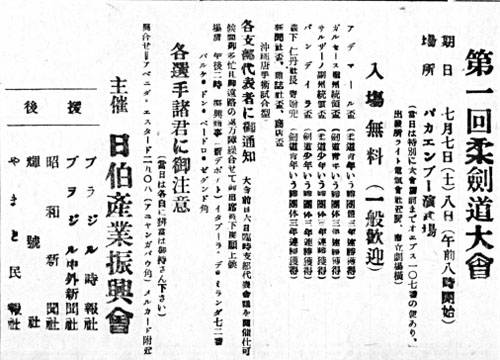
Photo: Notice of Jūdō ‘ Kendō Tournament Event from Burajiru Jihō, Published on July 4, 1951.
Here are the announcement and program for the demonstration held in Brazil, São Paulo in 1951. However, due to copyright reasons, the original text cannot be published, so it will be transcribed verbatim below.
This is magnificent! Did you know about the darling of the Japanese sports world? Excellent! The special skill from Okinawa, “Karatejutsu” , was demonstrated and showcased at the All Brazilian Jūdō and Kendō Championships held on the 8th.
The unique martial art of Okinawa, “Karatejutsu” , is said to embody three essential elements of training: the gentleness of a lamb in everyday interactions, the agility of a cat in sudden movements, and the strength of a tiger in combat. Because anyone can practice it, recently, Karate-dō has become a rising sport, as well as a favored self-defense technique in Japan, especially in Tōkyō and Ōsaka. It is welcomed not only among students but also among the general public as a hobby sport. At the first All Brazil Jūdō and Kendō Championships held at the Pacaembu Stadium on the 8th [July], organized by the Japan-Brazil Industrial Promotion Association, Karate-dō, led by the disciples of Yabiku Mōtoku, was showcased for the first time, leaving a profound impression on the audience.
The demonstration on that day followed the program outlined below.
Demonstration of the principles and techniques of Karate-dō.
Leading: Karate-dō Shihan Yabiku Mōtoku (65 years old)
Performance Disciples: Toguchi Reiji (19 years old)
Kokuba [Gabriel] Seitoku (18 years old)
Kokuba [Oscar] Seiyū (16 years old)
1. Basic strengthening supplementation for physical activity (Six disciplines listed below omitted)
2. Primary physical activity
a. Za Shisei [Sitting posture], Seiza Kokyūhō [Seated breathing method],
Tanden Shūchūhō [Tanden concentration method], Kobushi nigiri kata [Method of holding a fist], Za Tobi [Seated Leap]
b. Kiritsu Shisei [Standing posture] = Tanden Shūchū [Tanden concentration], Ashi no Fumikata [Method of stepping], Hiza Waza [Knee techniques], Yoriashi
[Advancing step], Keri Waza [Kicking techniques], Keriage [Rising kick], Tobi-geri
[Jumping kick], Kobushi tsuki kata [Method of punching], Nuki-te [Spear hand], Saru Hiji [Enpi – monkey elbow].
3. Demonstration of Karate Kata (with Explanation)
Naihanchi (Shōrei-ryū) performing together
Gojūshiho performing together
4. Adaptive turning method
a. Za Shisei [Sitting posture] (omitted).
b. Kiritsu Shisei [Standing posture] = Jōtai Sayū Kutsu Zenshin Sayū Nagare [Upper body bending left and right, whole body flowing left and right], Hijo [jumping up], Zenpō Tenpuku [forward roll], Kōhō Tenpuku [backward roll].
c. Yokogake Shisei [Lying posture] Hankaiten [half turn], Hanritsu [half standing], Gishi [feigning death], Keriage [rising kick], Kentotsu [punch].
5. Demonstration of Karate Kata (with Explanation)
Kūsankū (Shōrin-ryū) – This Kata is the highest achievements of Karate, with the honor of having been demonstrated to the current Emperor during his time as Crown Prince.
6. Kumite (Application) – Nodo Osae [Throat restraint], Kubi-katame [Collar hold], Daki-shime [Bear hug], Kake-te [Hook hand], Kata-otoshi [Shoulder drop], Kubimaki [Neck winding], Saka-otoshi [Reverse drop], Bō to karate [Karate against Bō-Attack], Itawari-jutsu [Board breaking technique], Uchite [Striking hand], Tsukiken [Thrusting fist].
Characteristics of Karate
Karate is originally aimed at mastering self-defense techniques, cultivating courage, learning humility, and nurturing elegance. The techniques themselves are characterized by flexible and versatile movements, allowing for adaptation in various situations. As a martial art that encompasses both physical and mental aspects, practicing it entails the following features:
1. It can be practiced alone or with multiple people.
2. Practice can be conducted in narrow spaces without hindrance.
3. While having a well-equipped dōjō is ideal, practice can be done indoors or outdoors without any specific installation.
4. While training aids may be used, practice can also be conducted without them.
5. Regardless of age, training intensity can be adjusted according to one’s physical strength, making it particularly suitable for middle school students and adults, including women, as a form of self-defense.
6. With mastery of Karate, one can engage in solitary physical and mental training.
7. The appeal of Karate lies in its ability to combine martial arts with hobbies and immediately incorporate them into physical exercise, allowing practitioners to tailor their training depth according to their preferences.
[Source: Burajiru Jihō, published Wednesday, July 11, Shōwa 26 (1951)]

Toguchi Reiji performing Gojūshiho
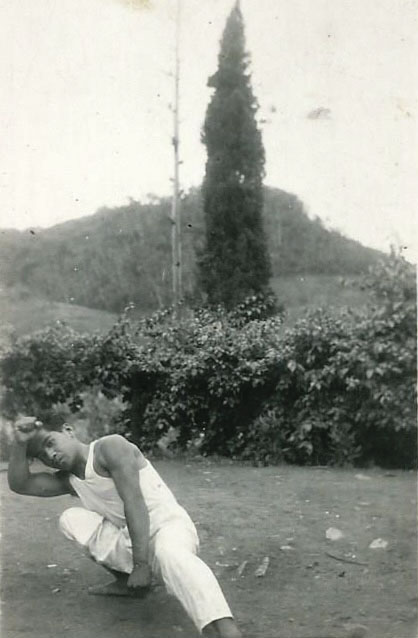
Toguchi Reiji performing Kūsankū
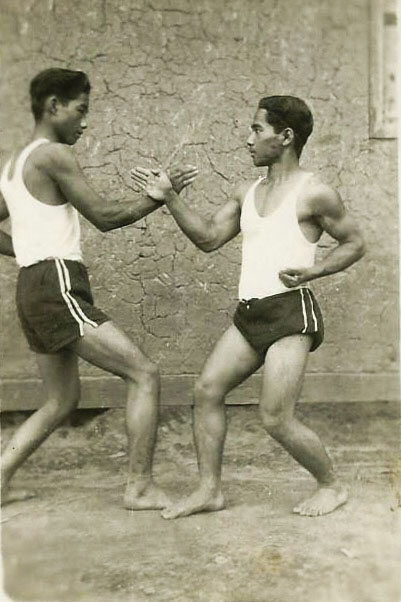
Kokuba Seitoku (left) and Toguchi Reiji (right) practicing Kakidî.
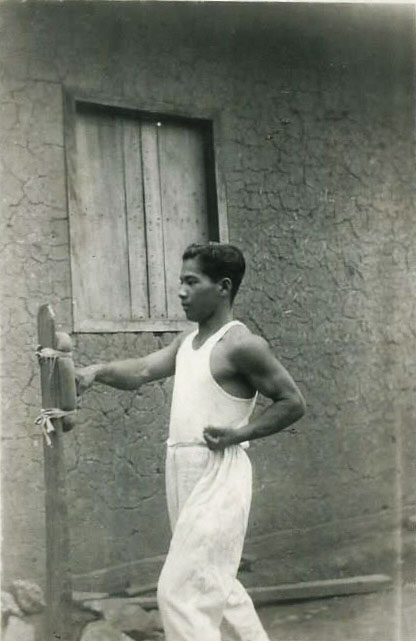
Toguchi Reiji practicing makiwara striking
These pictures are part of a 14-collection set. They were taken between 1948 and 1951 in Miracatu, Brazil, at the Banana Plantation of Yabiku Mōtoku.
[provided by Marcelo Yabiku]
Karate Promotion Activites by Yabiku Mōtoku and his Descendants
The main figure in this demonstration event was Yabiku Mōtoku, who led the event as a Karate Shihan. Yabiku studied karate under Yabu Kentsū at the Okinawa Normal School from 1905 to 1909. He was also a senior to Tokuda Anbun and Tōyama Kanken.

Yabiku Mōtoku
Yabiku Mōtoku, who was originally from Sashiki Town, began working as a primary school teacher in Okinawa after graduating from the Okinawa Normal School. In 1917, at the age of 31, he emigrated to Brazil alone. In this new land, he engaged in agriculture, worked as an interpreter, and was involved in construction as a businessman. The settlements he established included Campestre at the Noroeste Line Lins Station and Musácea along Linha Juquiá Line, both referred to as “Yabiku Colonies” . His eldest son, Yabiku Mōfu, joined him in 1932, followed by his wife and second son, Mōkyō, in 1933.
Yabiku assumed the position of the 13th chairman of the Okinawa Association of Brazil in 1938, but the exact time when he began teaching karate to the youth in this community is unclear. However, according to Yabiku Marcelo, the great-grandson of Yabiku Mōtoku and a resident of Brazil, “My great-grandfather taught karate on the family-owned banana plantation, where a Makiwara was also set up” . Marcelo provided photos for reference. (Refer to the photo of the young men demonstrating karate).
A videotape containing footage of the situation at that time
In 2016, a videotape capturing scenes of a demonstration organized by Yabiku was made public to the Brazilian karate community and was uploaded to YouTube by the grandson of Kokuba Seitoku. This videotape provides valuable insight into the events of that time, offering a glimpse into the actual venue. While this footage was previously known only to members of the Brazilian karate community and some members of the international social media karate community, it has now been provided for publication in this magazine through the generosity of Yabiku Marcelo, whose family is the owner of the tape. Please refer to the included QR code to view the footage from that time.

According to the Burajiru Jihō, they performed kata such as Naihanchi, Gojūshiho, and Kūsankū. Additionally, it mentions an event in 1921 where Funakoshi Gichin demonstrated Kūsankū in front of the Crown Prince, who later became Emperor Shōwa. However, Yabiku Mōtoku had already immigrated to Brazil by 1917 and did not participate in the event where Funakoshi demonstrated the kata to the Crown Prince. Therefore, it is likely that this information was based on hearsay or acquired knowledge from reading Funakoshi Gichin’s books.
Furthermore, in the demonstration captured on the videotape, three young men (Toguchi Reiji and the Kokuba brothers) are featured. They represent the second generation of Okinawan immigrants who moved to Brazil in the 1930s. However, details about these three young men are not clear, so they remain a subject for future research.
What’s particularly intriguing is that from the contents of this demonstration, it has become apparent that there was a “Yabu Kentsū Karate Method” devised by Yabu Kentsū. These methods likely started with basic supplementary exercises and encompassed a series of movements including sparring and stick techniques. It’s plausible to speculate that Yabu instructed this method at the Okinawa Normal School.
Furthermore, it’s noteworthy to focus on the term “Karate” in the program. Since Yabiku had already immigrated to Brazil before the renaming process from “Chinese Hand” to “Empty Hand” (karate), which took place in Okinawa in October 1936, the program uses the traditional character “唐” (Chinese) instead of the renamed “空” (Empty).
The Death of Yabiku Mōtoku
However, just two months after this demonstration, Yabiku Mōtoku passed away in August 1951 at a hospital in São Paulo. He was 65 years old. It is unclear whether his disciples, such as Toguchi and the Kokuba brothers, continued practicing karate after Yabiku’s death. According to Yabiku Marcelo, none of Yabiku Mōtoku’s sons carried on their father’s karate legacy.
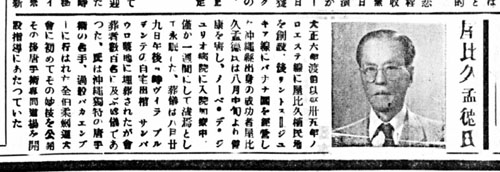
Photo: Obituary for Yakibu Mōtoku,
Since moving to Brazil in 1917, Yabiku Mōtoku, a successful Okinawan émigré, founded the Yabiku Colony along the Noroeste line and later managed a banana plantation along the Santos II and Juquiá lines. He fell ill in mid-August and was hospitalized at Nove de Julho Hospital. Within just a week, he passed away suddenly. His funeral was held on the afternoon of August 29, with a procession from his home in Vila Prudente to the São Paulo cemetery, where he was laid to rest in a grand ceremony attended by hundreds of mourners.
He was a master of the unique Okinawan martial art of Karate-jutsu. At the recent All-Brazil Jūdō and Kendō Tournament held at Pacaembu, he publicly demonstrated its techniques for the first time. Subsequently, he established and taught at a dōjō specializing in Karate-jutsu. [published in the Burajiru Jihō on September 7, 1951.]
Yabu’s ”Gojūshiho” and ”Kūsankū”
The demonstration led by Yabu Kentsū in Hawai’i can be considered the first big karate event held within the U.S. territory. Despite the low global recognition of karate at that time, this event attracted a large audience. From the programs of both overseas karate demonstrations in Honolulu and São Paulo, it is evident that Yabu’s two signature katas, “Gojūshiho” and “Kūsankū” , were featured prominently. I plan to delve deeper into Yabu’s “Gojūshiho” and “Kūsankū” in future installments, but for now, I will conclude here.
Next time, I will look back at Miyagi Chōjun’s demonstration in Hawai’i in 1934, based on historical documents from that period. Additionally, I will cover the events and seminars held by the Traditional Okinawan Gōjū-ryū Karate-dō Federation (TOGKF) to commemorate the 90th anniversary of Miyagi Chōjun’s visit to Hawai’i. I hope you continue to look forward to my upcoming article.
References:
- Ryūkyū Kenpō Karate / Funakoshi Gichin / Kukyōsha / 1922
- Rentan Goshin Karate-jutsu / Funakoshi Gichin / Kōbundō / 1925
- Tōyama Kyūzō den – Okinawa kaihō no Senkusha / Wakugawa Seiei / Taihei Shuppansha / 1973
- Uchinanchu – A History of Okinawans in Hawaii / Center for Oral History, University of Hawai’i at Manoa/ Hawai’i United Okinawa Association / 1981
- Shitsu to Kuden ni yoru Okinawa no Karate – Sumō meijin den / Nagamine Shōshin / Shin Jinbutsu Ōraisha / 1986
- Kenpō Gaisetsu / Miki Jisaburō & Takada Mizuho / Gajumaru Shorin / 2002
- Sashiki-chō – go – Imin / Sashiki chō Shi henshūiinkai / Sashikichō Yakuba Shuppan / 2004
- Kentsu Yabu’s Senior Students in Hawaii / Goodin, Charles C. / Classical Fighting Arts#8 / 2006
- Postwar Emigration to South America from Japan and the Ryukyu Islands / Pedro Iacobelli / Bloomsbury Publishing / 2017
- The Japanese Empire and Latin America / Edited by Iacobelli, Pedro & Lu, Sidney Xu / University of Hawaii Press / 2023

